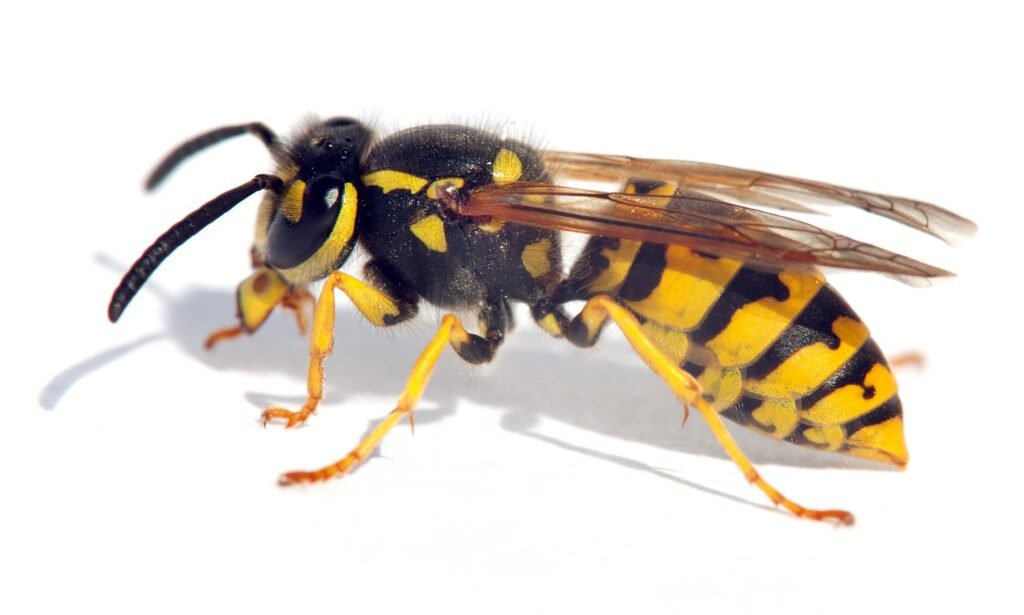
Wasp exterminator
Wasp exterminator: They are commonly called yellow jacket. Yellow jacket or Wasp belong to the order “Hymenoptera”. Worker wasp are 15 mm long and brown in color with yellow markings. Usually less than 12 wasps live in one nest. There nest is most commonly in old buildings. Wasp usually don’t sting unless they are disturbed or their nest is molested. We are expert in wasp removal.
Bee is hairy while wasp have just few hairs. There stinger is not barbed; this means wasp can sting more than once. Wasps have 2 sets of wings and 6 legs. They have antennae and “pinched-in” or hourglass waists. They also have chewing mouthparts (mandibles) to chew prey and other food sources.
Mostly they feed on insect larvae, and rotten fruit. Due to this reason wasp are more common in orchards. Mated female will over winter while male and unfertilized wasp will die as the winter arrive.
wasp Control
Wasp exterminator: Usually wasp attracted to sweet foods and food containing proteins. They are usually hunting for foods and stings only if someone approach their nest by accident. Wasp stings can uncomfortable but people usually recover quickly. Wasps bite when they feel danger, they have a stinger for self-defence. A wasp’s stinger contains venom that’s transmitted to humans during a sting.
wasp bite, How to prevent it
To prevent wasp bite, don’t leave left over food especially sugar beverages. When outside don’t wear scented products like perfume? Keep your food in tight container and through left over food in tight lid bin.
Female wasp have stingers (ovipositors) which are used to lay eggs. They will also use the ovipositor to sting when threatened. Wasp usually don’t sting unless provoked. A wasp will normally only use its sting to defend itself or to subdue prey. Many wasps’ stings are the result of people squashing wasps, either deliberately or by accident. Wasps are attracted to food and sweet drinks. Wasps sting intruders to defend their nest. When a wasp nest is disturbed, wasps will fly out with a wing beat frequency that stimulates other wasps to fly out the nest and attack. Usually will attack an intruder within 7 meters of the nest and pay special attention to moving targets.
Mir Akbar, the owner of Mirak Pest Control, is a highly skilled and dedicated pest control technician with over a decade of hands-on experience in the industry. As a certified pest control technician, trained and certified by the Ontario Pesticide Training and Certification Authority, Mir has established himself as a trusted expert in the field of pest management.
Mir’s journey in pest control began over 10 years ago when he developed a passion for helping people maintain safe, healthy environments free from the dangers and discomforts of pest infestations. His extensive experience, coupled with his certification, has equipped him with a deep understanding of the most effective and safe pest control methods.
Over the years, Mir has built a reputation for his commitment to using environmentally friendly practices and ensuring the safety of his clients, their families, and their pets. His approach to pest control is not just about eliminating pests but also about providing peace of mind to homeowners and businesses across Oakville, Burlington, Mississauga, and the surrounding areas.
Under Mir’s leadership, Mirak Pest Control has grown into a respected and reliable service provider known for its personalized, customer-focused approach. Mir takes pride in offering affordable, high-quality pest control solutions that meet the unique needs of each client. His dedication to his work and his community is evident in every aspect of his business.
When he’s not working, Mir is continually educating himself on the latest advancements in pest control to ensure that he can offer the most up-to-date and effective services to his clients. His passion for the industry and commitment to excellence make him not only a skilled technician but also a trusted partner in maintaining safe and pest-free environments.
